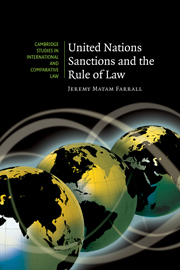Book contents
- Frontmatter
- Contents
- Extended Table of Contents
- Preface
- Abbreviations
- Part I Setting the scene
- Part II The evolution of the UN sanctions framework
- Part III UN sanctions in practice
- 5 Establishing the legal basis for sanctions: identifying threats and invoking Chapter VII
- 6 Delineating the scope of sanctions and identifying targets
- 7 Fine-tuning sanctions: setting objectives, applying time-limits and minimising negative consequences
- 8 Delegating responsibility for sanctions administration and monitoring
- Part IV Strengthening the rule of law
- Appendix 1 Summary of policy recommendations
- Appendix 2 Summaries of UN sanctions regimes
- Appendix 3 Tables
- Bibliography
- Index
- Cambridge Studies in International and Comparative Law
6 - Delineating the scope of sanctions and identifying targets
Published online by Cambridge University Press: 26 June 2009
- Frontmatter
- Contents
- Extended Table of Contents
- Preface
- Abbreviations
- Part I Setting the scene
- Part II The evolution of the UN sanctions framework
- Part III UN sanctions in practice
- 5 Establishing the legal basis for sanctions: identifying threats and invoking Chapter VII
- 6 Delineating the scope of sanctions and identifying targets
- 7 Fine-tuning sanctions: setting objectives, applying time-limits and minimising negative consequences
- 8 Delegating responsibility for sanctions administration and monitoring
- Part IV Strengthening the rule of law
- Appendix 1 Summary of policy recommendations
- Appendix 2 Summaries of UN sanctions regimes
- Appendix 3 Tables
- Bibliography
- Index
- Cambridge Studies in International and Comparative Law
Summary
Once the Security Council decides to apply sanctions, it must decide which of a range of possible measures to employ. Article 41 outlines an inclusive, rather than an exclusive or exhaustive, list of measures that might be taken to address threats to the peace, breaches of the peace or aggression. It thus provides the Security Council with considerable flexibility to determine which particular measures might be appropriate for each individual case. The Council also has broad discretion concerning the target(s) against which sanctions are to be applied.
The many types of UN sanctions
In practice, the scope of sanctions employed by the Security Council has varied from sanctions regime to sanctions regime and even within a particular regime, as the Council has expanded or contracted the measures applied in order to induce or reward a target's compliance. With the exception of regimes consisting of basic arms embargoes, no two sanctions regimes have been precisely the same. Sanctions regimes usually contain a blend of different types of sanctions. These can be broadly divided into the categories of economic and financial sanctions, and non-economic sanctions.
In order to determine the scope of a particular sanctions regime at a particular time, it is necessary to take into account both the range of prohibitions directed against a target, as well as any exemptions provided from those prohibitions. Almost every UN sanctions regime has contained exemptions of some description. Sanctions committees are generally tasked with responsibility for receiving and deciding upon applications for exemptions.
- Type
- Chapter
- Information
- United Nations Sanctions and the Rule of Law , pp. 106 - 132Publisher: Cambridge University PressPrint publication year: 2007



